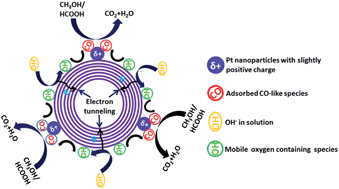Significance of wall number on the carbon nanotube support-promoted electrocatalytic activity of Pt NPs towards methanol/formic acid oxidation reactions in direct alcohol fuel cells
Abstract
For the first time it has been demonstrated that number of walls in pristine carbon nanotube (CNT) supports has significant effects on the electrocatalytic activity of Pt nanoparticles (NPs) towards methanol and formic acid oxidation reactions in alkaline solution, showing a distinctive volcano-type dependence of the catalytic performance on the number of walls of CNTs. In this study, Pt NPs of a similar size were uniformly self-assembled on CNTs with different numbers of walls and outer diameters to be used as model catalysts. The electrocatalytic activity and stability of Pt NPs showed distinctive volcano-type curves as a function of the number of walls with the best results being obtained using CNTs with an average of 7 walls. Such an unusual promotion effect can be ascribed predominantly to the high affinity of oxygen-containing species such as OHads, which facilitate the removal of adsorbed CO species and promote fast electron transfer between the outer walls and the inner tubes of CNTs, most likely through electron tunneling under the electrochemical polarization driving force. This study demonstrates the new possibility of tailoring the electrocatalytic properties of precious metal catalysts via altering the electronic and quantum transport properties of their CNT supports.

- This article is part of the themed collection: 2014 Journal of Materials Chemistry A Hot Articles

 Please wait while we load your content...
Please wait while we load your content...